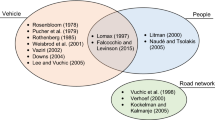Abstract
This study analyzed the performance of transit services using data collected from Automatic Fare Collection (AFC) system in Seoul with respect to service measures such as schedule adherence of metro, occupancy (crowdedness), and the operational speeds of buses. In order to analyze the transit services performances, we developed data-mining logics and applied them to a case study. These logics successfully indicate the route segment with a low Level of Service (LOS) for metro punctuality and bus operational speeds during peak hours (i.e., 7 a.m. to 9 a.m.). Further, a relationship between vehicle occupancy and punctuality on certain transit route segments is easily found based on the logical analysis. These empirical applications are beneficial to transit agencies and planners for improving transit service performances by using massive amount of data.
Similar content being viewed by others
References
Bagchi, M. and White P. R. (2005). “The potential of public transport smart card data.” Transport Policy, Vol. 12, No. 5, pp. 464–474, DOI: 10.1016/j.tranpol.2005.06.008.
Blythe, P. (2004). “Improving public transport ticketing through smart cards.” Proceedings of the Institute of Civil Engineers: Municipal Engineer, Vol. 157, No. 1, pp. 47–54, 10.1680/muen.2004.157.1.47.
Bryan, H. and Blythe, P. (2007). “Understanding behavior through smartcard data analysis.” Proceedings of the Institution of Civil Engineers: Transport, Vol. 160, No. 4, pp. 173–177, DOI: 10.1680/tran.2007.160.4.173.
Cao, S., Yuan, Z., Zhang, C., and Zhao, L. (2009). “LOS classification for urban rail transit passages based on passenger perceptions.” Journal of Transportation Systems Engineering and Information Technology, Vol. 9, No. 2, pp. 99–104, DOI: 10.1016/S1570-6672(08)60059-8.
Chu, K. A. and Chapleau, R. (2008). “Enriching archived smart card transaction data for transit demand modeling” Transportation Research Record: Journal of the Transportation Research Board, No. 2063, Transportation Research Board of the National Academies, Washington, D.C., pp. 63–72, DOI: 10.3141/2063-08.
Eboli, L., and Mazzulla, G. (2011). “A methodology for evaluating transit service quality based on subjective and objective measures from the passenger’s point of view.” Transport Policy, Vol. 18, No. 1, pp. 172–181, DOI: 10.1016/j.tranpol.2010.07.007.
Han, J. and Hayashi, Y. (2008). “A data envelopment analysis for evaluating the performance of China’s urban public transport systems.” International Journal of Urban Sciences, Vol. 12, No. 2, 173–183, DOI: 10.1080/12265934.2008.9693639.
Jang, W. (2010). “Travel time and transfer analysis using transit smart card data.” Proceedings of 89 th Annual Transportation Research Board Meeting, Washington, D.C., DOI: 10.3141/2144-16.
Lim, Y., Kim, H., Limanond, T., and An, S. (2013). “Passenger transfer time in the seoul metropolitan intermodal system: Can smart-card data assist in evaluating and improving the transit system?.” ITE Journal, pp. 33–37.
Takyi, I. K. (1993). “A multidimensional methodology for evaluating public transportation services.” Transportation Research Part A: Policy and Practice, Vol. 27, No. 5, pp. 395–405, DOI: 10.1016/0965-8564(93)90035-J.
Trépanier, M., Tranchant, N., and Chapleau, R. (2007). “Tranchant, individual trip destination estimation in transit smart card automated fare collection system.” Journal of Intelligent Transportation Systems: Technology, Planning, and Operations, Vol. 11, No. 1, pp. 1–15, DOI: 10.1080/15472450601122256.
Trépanier, M., Morency, C., and Agard, B. (2009). “Calculation of transit performance measures using smartcard data.” Journal of Public Transportation, pp. 79–96.
Utsunomiya, M., Attanucci, J., and Wilson, N. H. (1971). “Potential uses of transit smart card registration and transaction data to improve transit planning.” Transportation Research Record: Journal of the Transportation Research Board, No. 1971, Transportation Research Board of the National Academies, Washington, D.C., pp. 119–126, DOI: 10.3141/1971-16.
Wei, C. M. and Kao, C. Y. (2010). “Measuring traveler involvement in urban public transport servias: The case of Kaohsiung.” Transport Policy, Vol. 17, pp. 444–453.
Author information
Authors and Affiliations
Corresponding author
Rights and permissions
About this article
Cite this article
Eom, J.K., Song, J.Y. & Moon, DS. Analysis of public transit service performance using transit smart card data in Seoul. KSCE J Civ Eng 19, 1530–1537 (2015). https://doi.org/10.1007/s12205-015-0013-0
Received:
Revised:
Accepted:
Published:
Issue Date:
DOI: https://doi.org/10.1007/s12205-015-0013-0




